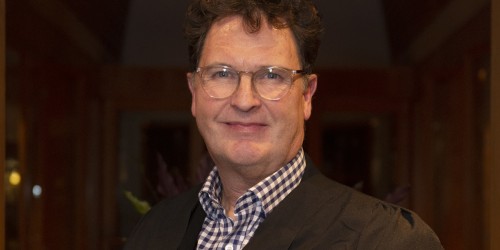
Report confirms successful impact of Babraham Research Campus on UK’s early-stage bioscience enterprises
Derek Jones, Lucy Fellow and CEO, Babraham Bioscience Technologies, thanks staff for success of the campus
Derek Jones, College Fellow and Chief Executive at Babraham Bioscience Technologies Ltd talks about the opportunities available at Babraham campus
South of Lucy, way beyond Realty Checkpoint, past Addenbrookes Hospital over the Magog Downs, and over the steepest hill around Cambridge, lies the village of Babraham. A quiet village. No post office, no shop, basically a street with a pub. But Babraham village is also the location to one of the most successful research communities in the UK, if not Europe. The Babraham Research Campus is home to over 60 life sciences companies, co-located with the world class academic science of the Babraham Institute. The topology of the area means that as you pass on the A3107, you will see the campus roundabout and a glimpse perhaps, of the 19th Century Babraham Hall, but would have no idea of the extent of the 400 acres, dozens of offices and laboratories and 2,000 employees on site.
World-class research
The Babraham Institute - the academic heart of the campus was established soon after the war in 1948 as the Institute of Animal Health with a focus on animal physiology. That work on animal health has long gone. Now the Babraham Institute, with strategic funding from the UKRI-Biotechnology and Biological Sciences Research Council (BBSRC), is a leading institute that undertakes world class research into understanding the biology of how our bodies work, including what changes as we age and during disease. The research covers 3 broad research areas: (i) Epigenetics (the study part of genome which is fundamental to how, when and where genes and gene products are produced which is a mixture of inheritance, nutrition, and the environment); (ii) Cell signalling (how proteins control communications between and within cells); (iii) Lymphocyte Signalling (a key part of our immune system, that protects us from infection). The Babraham Institute has a long and illustrious history. It was here that liposomes were discovered, the importance and mechanisms of PI3 Kinase proteins was established, and some of the early work on antibodies and humanisation of antibodies was undertaken. All these relevant to human health and the treatments and medicines we rely upon today.
The location of choice for investors and entrepreneurs
What is distinct about the campus is with whom the Babraham Institute share their home. The Babraham Research Campus is often the location of choice for entrepreneurs and investors to setup and scale-up their life-science company. This is the home to early career science entrepreneurs to start-ups with perhaps a handful of employees, to companies who came to the campus with less than a dozen staff and now employ over 150. We can help facilitate the growth of a concept into a company, and to provide space from a shared bench to a whole building on a single site.
There have been notable commercial success stories from the campus. These include Cambridge Antibody Technologies (CAT) which later became part of Medimmune and thus now Astra Zeneca. CAT was established on the campus by the Nobel Prize winner and previous Master of Trinity College, Prof. Sir Greg Winter. Another success is Horizon Discovery which outgrew its space on site and relocated to its own buildings north of Cambridge. One of the founders of Horizon Discovery, Dr Chris Torrance, has founded other life science companies including Phoremost, which is based on the campus.
Babraham Bioscience Technologies (BBT), of which I am the Chief Executive, is a for-profit business responsible for the development and management of the Babraham Research Campus for two shareholders; the Babraham Institute and the BBSRC. The latter being the land freeholder and the source of virtually all the tax-payers funding for the campus development. That funding has amounted to about £100M.
So what is the purpose of the campus and why is funded by the tax payer? Life science start-ups are distinct from other early stage ventures for several reasons. First, they are generally high risk often with binary outputs of scientific or clinical success or failure, but with potential high return for investors. Second, they need specialised facilities, laboratories generally, and the infrastructure needed to support their science (e.g. access to high cost, complex capital equipment). Third, it is most often a multi-disciplinary collaborative endeavour requiring input from other organisation and external teams.
The uncertain viability and high-risk profiles (perhaps with limited funding) makes them unattractive for commercial science parks. Newly funded enterprises need access to space that matches their funding cycles. They need to have access to science capabilities, resources on an as-needs basis and they want to be in a mutually supportive entrepreneurial environment with visibility to investors, partners, and potential customers. The campus and BBT help fix this “market failure”, as these elements are often not available on “property-centric” locations. BBT is “impact centric”, whilst operating on commercial terms. Our role at BBT and the campus is to maximise the impact of UK science, to support the creations of new jobs, new science and new therapies.
Our focus is not about property (although all our rents are on commercial terms and costs!), rather it is to create an environment where life-sciences companies can focus on their science. That may be through multi-occupancy buildings we manage. It can be through investment and science events we run on site (we have a 300 person lecture and conference centre which is utilised and is available to the wider community). In addition, it could be by facilitating access to critical high-tech equipment (often made available by the Babraham Institute). We also encourage early-stage entrepreneurship through our Accelerate@Babraham programme. The campus is an active and vibrant life-science community in a campus environment: We are not a science park.
So is there any evidence of success of the campus impact on the Cambridge region or the UK more widely? Later this year we will launch a report that shows how the campus has made an impact, scientifically, economically and socially. As a taster for example, is that the market capitalisation of the campus companies has now reached over £4 Billion; our Gross Value Added (GVA) contribution to economy has grown 3 fold, and being located on the campus appears to accelerate speed and scale of company activities. This all provides evidence that considerable value can be realised by well targeted public sector investment in key economic areas such as life sciences.
Support for early-career science entrepreneurs
So how are we supporting early-career science entrepreneurs? One of the ways we do this is through our Accelerate@Babraham programme. In this we are strategically supported by Astra Zeneca, BBSRC, Eisai, Life Arc, MundiPharma, and a plethora of mentors and advisors. There is an annual competition (which is open now despite COVID19!). Up to 5 prizes are awarded which includes a cash grant, 5 months location at the campus with access to the communal laboratories, boot-camp sessions, etc. The focus is on helping early-stage companies define their business proposals, undertake laboratory work and hone their pitch. The feedback we have had from previous cohorts has been about the positive experience of the programme and the progress they have made from being a winner. There are a few caveats as to eligibility; one being you must be a team, not an individual. It is an exciting and worthwhile programme, I would encourage you to look into it if you have that entrepreneurial streak and a scientific idea that you want to develop into a viable life science business.
See our website, https://www.babraham.com/ to look at the previous winners and apply.
The Babraham Research Campus is an example that demonstrates that you don’t need to be in the centre of Cambridge to be in the centre of the action!
About Derek Jones
Derek Jones is Chief Executive at Babraham Bioscience Technologies Ltd at the Babraham Research Campus. Derek’s wealth of experience includes over 25 years' in the life-science industry as both a scientist and in business development and corporate development, with first-hand experience of establishing biomedical ventures. Read more

Derek Jones, Lucy Fellow and CEO, Babraham Bioscience Technologies, thanks staff for success of the campus

Lucy student Nicola Filzmoser wins 10K Cambridge University Entrepreneurs prize with ‘Happyr Health’